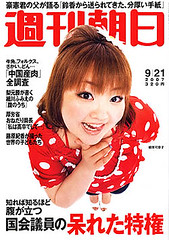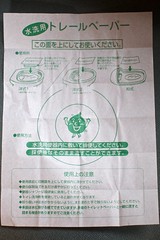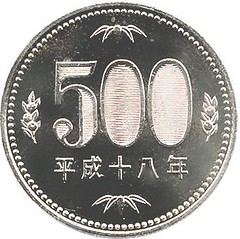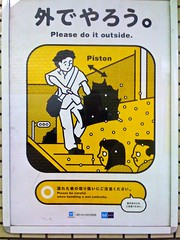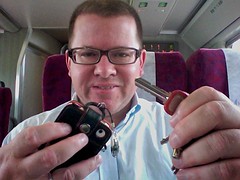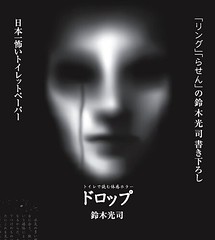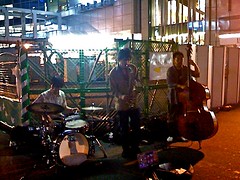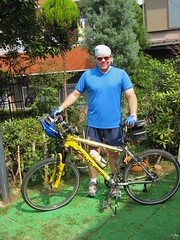 Recently Japan law regarding bicycles has been strengthened, and it is a popular topic on TV "wide shows" (variety shows) as I write this, in Autumn 2011.
Recently Japan law regarding bicycles has been strengthened, and it is a popular topic on TV "wide shows" (variety shows) as I write this, in Autumn 2011.
The scapegoat being used by the media is "fixies" or the fashionable piste-style bikes that usually have a friction brake in the hub. I haven't ridden a friction brake bike since the 6th grade, but the way it works is you stop by reverse-pedaling, or by skid-sliding. A Big Deal has been made about how evil fixie riders are, emphasizing their delinquency and propensity for riding with no brakes. So fixie riders in Japan have been dutifully putting caliper brakes on, lest they get stopped by the overzealous cops. Personally, I think the root of all evil is the mama-chari (cheap utility bike that moms ride) being driven by drunk salarymen, kids texting or listening to music, or the elderly, but anyway, the whipping boy du-jour is the fixie rider.
So I thought I'd post, to organize some information about the situation and laws as I can understand them, and in hopes that this will help hapless gaijin everywhere in Japan.
Just to give some background, I ride an urbanized mountain bike from Centurion, which I bought when I was not sure if I would like cycling. I wanted something decent, but that would not break the bank. Well, I really came to love cycling, and started upgrading my MTB, adding nice Mavic rims, a new Shimano Deore XT groupset, a light saddle and seatpost, and a carbon handlebar to name a few. The bike is lighter with the new components, but certainly it is more of a slog to ride compared to a road bike. Well, I'm busy with work and as much as I would love to ride daily, I am a "weekend warrior", usually cycling here in the Kanagawa area, especially down south to Shonan and up north to around Machida or Sagami-Hara. The bike roads are pretty good, the terrain varied, and the scenery is nice and rural. I love it!
Anyway, to get to the point...
What are the Basic Cycling Rules in Japan?
The basic rules for cyclists in Japan are as follows:
- Cyclists are supposed to follow the same basic rules as motorists, and heed road signs.
- Cyclists should use cycling paths if they exist, or the motorway, keeping to the left. If the motorway is impassible, cyclists can use sidewalks or other pedestrian roads unless there is a sign prohibiting it, but must yield to pedestrians. Cyclists should avoid extremely crowded pedestrian areas.
- Cyclists must proceed on the left. Cycling against the flow of traffic is not allowed. If you are going down a sidewalk, stay on the side closest to the road, unless there is a designated bike lane on the sidewalk. Inside the bike lane, keep to your left.
- Cyclists take responsibility in any accident involving a pedestrian.
- Cycling on toll roads or highways is generally prohibited, but it should be marked as such.
- Bike helmets are not required by law, but are "strongly recommended".
- At night, lights in front and rear, and reflectors, are required. Cyclists without the required lighting can be stopped by police.
- Besides the requisite lights and reflectors, bicycles also need a front and rear brake.
- Cyclists must stop and look at train crossings.
- Cycling while under the influence of alcohol is illegal and a punishable offense.
Of course reality is always different from a set of rules, so let me make some comments on that:
- I feel that in Japan, at least where I am (Kanagawa and Tokyo), there is indeed an awareness of cyclists, mostly, but even though you are supposed to ride on the road, there are plenty of motorists and trucks parked along the shoulder. So, you end up having to kind of swerve out into traffic, or up onto the sidewalk as the case may be. I just use hand signals while I edge into traffic, and try to keep going fast.
- Roads are often pretty narrow, and even when they aren't, you have people who are not so aware, who edge close to the shoulder, making it difficult or dangerous to proceed on the left. I unclip in these cases, and just have to wait for traffic to flow, or, sometimes go up onto the sidewalk.
- I have had a few close calls especially with angry truck drivers and their dangerous side-mirrors, but mostly, motorists swerve out and around you. However, I would say the most danger has come from a), motorists and cyclists popping out of side roads without looking right, b), people walking diagonally or zig-zag on paths shared with pedestrians.
- Shoulders are often narrow with a ditch, so it is a little hairy riding on some roads with such a configuration. You end up on the car-side of the white line, since the shoulder is so dicey.
- There's no rule you have to use hand signals but I always do. Mostly, people see them and yield to you, but sometimes people don't quite get it, and even though you have right of way and are signaling a turn, they come barreling through.
- I have noticed that "bike roads" tend to morph. One excellent one without too many gate barriers is the Yamato-Fujisawa Bike Road. This used to be marked as a pure cycling road, but there must have been an accident, because a couple years back, they started putting up signs every 200m or so, to be careful of pedestrians. The likely scenario is that some lamebrain stepped out in front of a cyclist, going down the cycling road at 40kph, so the local civic groups petitioned for the signs and a change in the nature of the road itself. Now it is still marked as a cycling road, but it has pedestrians walking down it. I draw the line at people have picnics on the bike road, though. I pulled an "angry gaijin" on the group of ladies having a picnic literally in the middle of the bike road ( ! ), the other week. This is not a park!
There is confusion even amongst authorities who are supposed to know these things, about what the rules are, and I think that is because the rules have changed over time, especially those regarding use of pedestrian roads. Patience is a virtue.
What Exactly are the Police Looking For?
Riding while gaijin? No, probably not, but there are a few items which are mentioned in the law specifically, which you can be sure are the hot topics, so I will list them from least to most severe -
- Riding two or three cycles abreast or, riding with a passenger perched on the back (not referring to children in proper bike child seats) - JPY 20,000 fine or less
- Riding without lights at night, or, changing direction suddenly - JPY 50,000 fine or less
- One-handed riding, which means holding an umbrella, cell phone, texting, iPod and so on, or, failing to yield or drive carefully where required, or, failing to stop at a stop sign or light - JPY 50,000 or less fine and up to 3 months' imprisonment
- Endangering pedestrians - JPY 100,000 or less fine and up to 1 year imprisonment
- Drunken operation of a bicycle - JPY 1,000,000 or less fine and up to 5 years' imprisonment
When considering cases in which an accident caused bodily harm, it appears that in terms of responsibility, cars > motorcycles > bicycles > pedestrians. That means, if a car hits a bicycle or pedestrian, the car driver is always responsible and at fault, no matter how boneheaded the action of the cyclist of pedestrian. Same goes for you, on a bicycle. Heaven forbid you hit and seriously injure someone while you are on your bicycle. There might be some exception once in a blue moon, but they pretty much spell it out that the cyclist would always be at fault, and we hear horror stories of the cyclist getting jailed, and his family having to pay off massive debts. This can be more than a little bit nerve-wracking and knowing Japan, it's not an urban legend either.
Japan's Like That
It's probably a good idea to make a couple points now, about how Japan often is.
First, there's the concept of shared guilt. If you are involved in a fender-bender with another car, there is one case in which you won't have to pay. That's if the other guy admits 100% guilt, and the cops are kind enough to write that down. But most of the time, in the case of an accident, the insurance companies get in between, and start the "you're half to blame" dance. This would also happen in the case of two bicycles colliding. Probably, if both parties are genuine, and trying to help each other, it will end up amounting to nothing. But if you slam into a child or an elderly person, you can bet you will be entirely to blame, even if it is entirely their fault. Enough said.
Second, when there's something that gets peoples' ire up, you might see an overreaction or over-adjustment by police or by society in general. When some kid got killed by a crazy guy with a knife a few years back, it was found out that the guy jumped out of a tree. The response? Cut all trees back, so they look like ones from a Dr. Seuss book. Our city underwent serious uglification after that child got murdered.
Noting that there are no firearms here, another knife incident caused the law to be changed so that people could not carry knives with blades over a couple inches in length. When that law went into effect, the cops were so overzealous that a hapless elderly tourist got asked if he had a knife, and when he showed them his little Swiss Army pen-knife, they chucked him in jail! Talk about overreacting.
The point is, these laws just got strengthened, so don't be surprised that cops here and there in Japan will be extra vigilant in enforcing the rules.
Expect to have to stand at attention on this matter, for a while, until they loosen it up again.
Happy riding!













 The "Vegetarian" Fresh Juice Bar located in the New Shinbashi building 1st floor, has been in business for 40 years. They have various types of juice, but everything is in Japanese, so you would be well served with some ability in it, or to bring a friend to help. Prices are reasonable at 300 to 700 JPY, with egg or veg-fruit sandwiches available cheaply for juice customers.
The "Vegetarian" Fresh Juice Bar located in the New Shinbashi building 1st floor, has been in business for 40 years. They have various types of juice, but everything is in Japanese, so you would be well served with some ability in it, or to bring a friend to help. Prices are reasonable at 300 to 700 JPY, with egg or veg-fruit sandwiches available cheaply for juice customers.


















